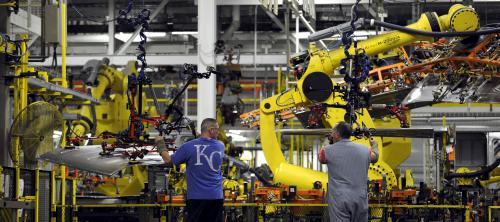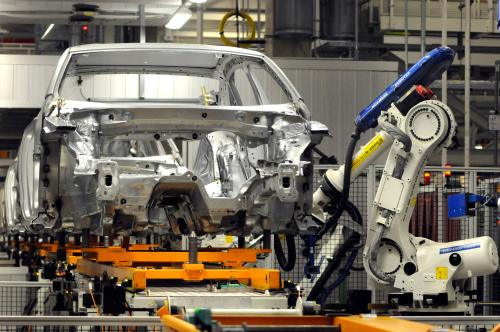Last week, as my colleague Sifan Liu and I were gnawing on some questions asked by Jim Tankersley of The Washington Post, we happened upon a revealing aspect of the election outcome. While looking at number of influences on the presidential vote outcome, we found that in a year of massive divides, one particular economic split stands out.
Our observation: The less-than-500 counties that Hillary Clinton carried nationwide encompassed a massive 64 percent of America’s economic activity as measured by total output in 2015. By contrast, the more-than-2,600 counties that Donald Trump won generated just 36 percent of the country’s output—just a little more than one-third of the nation’s economic activity.
Candidates’ counties won and share of GDP in 2000 and 2016
| Year | Candidates | # of Counties won | Aggregate share of GDP |
|---|---|---|---|
| 2000 | Al Gore | 659 | 54% |
| George W. Bush | 2397 | 46% | |
| 2016 | Hillary Clinton | 472 | 64% |
| Donald Trump | 2584 | 36% |
Source: Brookings analysis of Moody’s Analytics estimate
To see how this could be, take a look at this quick visualization, which suggests what’s going on:

Here you can see very clearly that with the exceptions of the Phoenix and Fort Worth areas and a big chunk of Long Island Clinton won every large-sized county economy in the country. Her base of 493 counties was heavily metropolitan. By contrast, Trumpland consists of hundreds and hundreds of tiny low-output locations that comprise the non-metropolitan hinterland of America, along with some suburban and exurban metro counties, as Indeed Chief Economist Jed Kolko pointed out in a tweet.
Moreover, while this divide is striking by any standard, it appears to be “unprecedented in the era of modern economic statistics,” as Tankersley noted in his story, for a losing presidential candidate to have represented so large a share of nation’s economic base. By comparison, Democratic Presidential candidate Al Gore in 2000 won counties that generated only about 54 percent of the country’s gross domestic product en route to winning the popular vote, while losing the election in the Electoral College. Gore, won more than 100 more counties in 2000 than Clinton did in 2016, meaning that his appeal, while less monolithic across high-output counties, extended into more lower-output areas.
The upshot: No election in decades has revealed as sharp a political divide between the densest economic centers and the rest of the country — between what Tankersley labeled in a tweet “high-output” and “low-output” America.
All of which suggests multiple problems. Most broadly, the stark political divide underscores the likelihood of the two parties talking entirely past each other on the most important issues of economic policy. Given the election map we revealed, the Trump administration will likely feel pressure to respond most to the desires and frustrations of the nation’s struggling hinterland, and discount the priorities and needs of the nation’s high-output economic base.
On one hand, more attention to the economic and health challenges of rural and small-city Rustbelt America could be welcome, especially if it focuses on the right things: realism about current economic trends, adjustment to change, improving rural education and skills training, and enhancing linkages to nearby metropolitan centers. However, Trump’s promises to “bring back” the coal economy and “bring back” millions of manufacturing jobs (that now don’t exist thanks to automation) don’t speak wisely to real-world trends in low-output America. They look backwards and speak instead to local frustrations.
On the other hand, our tile map raises doubts that the nation’s core metropolitan economic base will easily secure the investments it needs—investments that has been shown to drive broader prosperity that benefits the entire nation. Without a doubt, the mostly metropolitan counties of high-output America will need now to make more of their own arrangements, by establishing their own applied R&D centers, developing their own industry-relevant skills pipelines, and deepening local industry clusters. “Bottom up” will now be mandatory. Yet with that said, big issues loom given the fact that no county can flourish entirely on its own. How, for example, will high-output America secure the critical, historically federal innovation investments it requires to fuel the dynamism of its local advanced industries and the long supply chains that they support? How will the heavily federal safety net be maintained? And will necessary federal infrastructure investments be made in a targeted, efficient way that maximizes return on investment? Clearly, as my colleague Bruce Katz declares, cities and metropolitan areas are going to need to demand what they need, while taking matters into their own hands as best they can.
In the end, our data makes plain that while cultural resentments played a huge role in this month’s election, so too did a massive economic divide between relatively prosperous high-output counties and struggling lower-out rural ones. Hashing out a serviceable politics and policy mix to serve that bifurcated reality is going to be a huge challenge.








Commentary
Another Clinton-Trump divide: High-output America vs low-output America
November 29, 2016